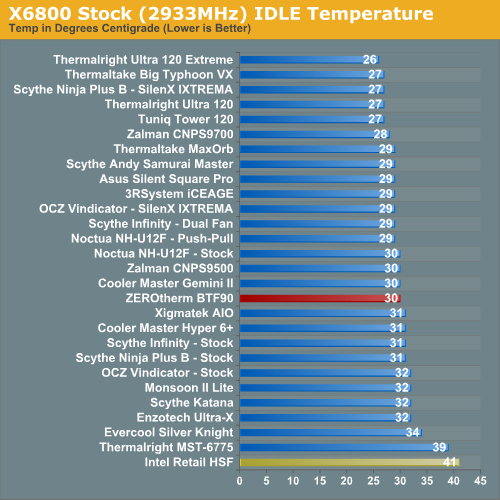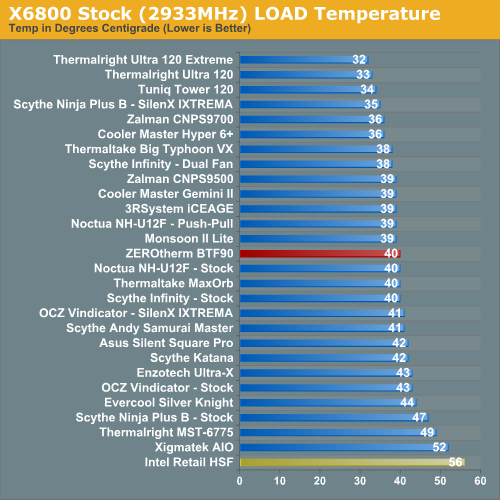ZEROtherm BTF90: Sting like a Butterfly?
by Wesley Fink on August 13, 2007 12:05 AM EST- Posted in
- Cases/Cooling/PSUs
Cooling at Stock Speed
Some users will never overclock their CPU, but they still want to run the coolest CPU temperatures possible to enhance stability and extend CPU life. The ZEROtherm BTF90 uses a 4-pin connector to allow the motherboard to control fan speed. The supplied fan is a standard 92mm size, but it is embedded and not user changeable.

Where the very good Intel stock cooler keeps the X6800 at 41C at idle, the BTF90 manages 30C. This is a significant improvement over the Intel stock cooler performance at 41C, but the results are average among top air coolers tested at AnandTech. The Thermalright coolers, at the top of our heatpipe tower performance charts, cool to 26C and 27C, and the Tuniq 120 maintains 27C. The BTF would likely do better if the fan were run at maximum speed at idle, since the speed is auto controlled by the temperature of the processor. Still, the performance is quite good for a cooler using a 92mm fan running at its slowest speed.
It is more difficult to effectively simulate a computer being stressed by all of the conditions it might be exposed to in different operating environments. For most home users CPU power is most taxed with contemporary gaming. Therefore our stress test simulates playing a demanding game.
The Far Cry River demo is looped for 30 minutes and the CPU temperature is captured at 4 second intervals with the NVIDIA Monitor "logging" option. The highest temperature during the load test is then reported. Momentary spikes are ignored, as we report a sustained high-level temp that you would expect to find in this recording configuration. This test configuration roughly equates to an 80% CPU load test using Intel TAT.
Cooling efficiency of the ZEROtherm BTF90 was then compared under load conditions at stock speed to the retail HSF and other recently tested CPU coolers.

The BTF90 under load at stock speeds reached a maximum temperature of 40C with the included fan at highest auto speed. This compares to the Thermalrights at 32C and 33C, the Tuniq at 34C, and the cooler Master Hyper 6+ and Zalman 9700 at 36C. Stock load performance is average among tested coolers. This is really a very good performance for a cooler using a 92mm fan when you consider that almost every other air cooler tested at AnandTech uses a 120mm fan for cooling.
Some users will never overclock their CPU, but they still want to run the coolest CPU temperatures possible to enhance stability and extend CPU life. The ZEROtherm BTF90 uses a 4-pin connector to allow the motherboard to control fan speed. The supplied fan is a standard 92mm size, but it is embedded and not user changeable.

Where the very good Intel stock cooler keeps the X6800 at 41C at idle, the BTF90 manages 30C. This is a significant improvement over the Intel stock cooler performance at 41C, but the results are average among top air coolers tested at AnandTech. The Thermalright coolers, at the top of our heatpipe tower performance charts, cool to 26C and 27C, and the Tuniq 120 maintains 27C. The BTF would likely do better if the fan were run at maximum speed at idle, since the speed is auto controlled by the temperature of the processor. Still, the performance is quite good for a cooler using a 92mm fan running at its slowest speed.
It is more difficult to effectively simulate a computer being stressed by all of the conditions it might be exposed to in different operating environments. For most home users CPU power is most taxed with contemporary gaming. Therefore our stress test simulates playing a demanding game.
The Far Cry River demo is looped for 30 minutes and the CPU temperature is captured at 4 second intervals with the NVIDIA Monitor "logging" option. The highest temperature during the load test is then reported. Momentary spikes are ignored, as we report a sustained high-level temp that you would expect to find in this recording configuration. This test configuration roughly equates to an 80% CPU load test using Intel TAT.
Cooling efficiency of the ZEROtherm BTF90 was then compared under load conditions at stock speed to the retail HSF and other recently tested CPU coolers.

The BTF90 under load at stock speeds reached a maximum temperature of 40C with the included fan at highest auto speed. This compares to the Thermalrights at 32C and 33C, the Tuniq at 34C, and the cooler Master Hyper 6+ and Zalman 9700 at 36C. Stock load performance is average among tested coolers. This is really a very good performance for a cooler using a 92mm fan when you consider that almost every other air cooler tested at AnandTech uses a 120mm fan for cooling.










19 Comments
View All Comments
angelicvoices - Friday, March 20, 2009 - link
I have this cooler and I am trying to remove the red LEDs. I can see from your shots where they're supposed to be but I can't actually see them on my cooler. Any help would be appreciated.andereandre - Tuesday, August 14, 2007 - link
my main interest in getting a new cooler, is lowering the noise.Now in these articles the Intel HSF is always classified the same as the best coolers (and system-ps & no fans).
That would suggest that would I be an Intel user, I would not gain anything by replacing it.
I have a X2 4600 however, and I hear the AM2 stock cooler at idle.
Does this mean that de Intel stock cooler is that much better than the AMD one, or is it just the measurement?
I am just worrying that getting me a cooler like this one would not bring me what I am after.
Jodiuh - Monday, August 13, 2007 - link
It's a #$#%ing butterfly on your pc...are you serious?Thinkitect - Monday, August 13, 2007 - link
Why compare this cooler to the Tuniq in the conclusion? It's a different product serving a different purpose. It's like trying to arrange a fight between a heavyweight boxing championship contender with a medium weight rookie.It's fine to put the larger coolers on the same performance graphs to see the difference between categories and price ranges, but for the conclusion and main comparison you should have used the directly competing ones. For example the AC Freezer 7 Pro and the Scythe Ninja Rev.B are popular in the price range (from researching for an HSF last month) - which one of the three outperforms the others? That could have been a sensible conclusion.
Your reviews have a purpose - meaningful and accurate comparisons between products. You are doing an excellent job with the research and data presentation, please get the written analysis on the level. Thank you.
Wesley Fink - Monday, August 13, 2007 - link
Sites like Tiger Driect and Amazon still show the BTF90 selling price as $60, which means it competes at the top. That is why we tried to carefully point out the plus and minus points of the BTF90 compared to the Thermalrights and Tuniq. The BTF90 does not compete that well at the $60 price point.However, at its current selling price of $35 to $45 (after rebate) we think it competes very well and is worth considering.
Spanki - Monday, August 13, 2007 - link
Good article - It's nice to see you broadening your views (audience) somewhat :). If you really want to see bang-for-buck performance, I wish you'd add some like the CoolerMaster Hyper Tx (http://www.svc.com/rr-pch-s9u1-gp.html">for ~$15.00) and/or the Arctic Cooler Freezer 7 Pro (http://www.svc.com/acfzp7.html">generally available for ~$20-$25) to the lineup.Not everyone wants to spend ~$60 - $$80 (or more) on a HSF, so it would be nice to see where these cheaper coolers fall by comparison - of course the results will embarrass some of the higher dollar coolers - but that's kinda the point, isn't it? You don't always get what you pay for.
strikeback03 - Tuesday, August 14, 2007 - link
From tests I have seen, I'd guess the Freezer 7 would be the embarrassed one, but whatever.Wesley Fink - Monday, August 13, 2007 - link
We have added the following info to the overclocking page to put the analysis of this cooler and others in cleare perspective:"There is no doubt that the BTF90 is able to dissipate 150W or more of heat. This merely points out the extreme demands that our overclocking cooling tests make of coolers while we push an X6800 processor to its overclock limits. The power requirements of a Core 2 Duo X6800 processor at rated speed and voltage is around 75 watts. At the overclocked speed of 3.830GHz at the commonly required 1.5375V to 1.5625V the wattage has doubled - to 148W to 153W. At the highest air OC with this X6800 of 3.94GHz with a Thermalright Ultra 120 eXtreme wattage has risen to 165W to 168W.
The stock Intel Retail cooler is really an excellent cooler, and the requirement that a tested cooler must perform better than the included Intel cooler is more demanding than you might think. THe Intel stock cooler topped out at 3.73 GHz at just below 1.5V. This means the stock Intel cooler is dissipating 135W at the highest overclock it could reach. These figures should help keep in perspective the relative efficiency of the coolers being tested and the extreme conditions of our maximum overclock cooling test bed."
RamarC - Monday, August 13, 2007 - link
the 'float like a butterfly' citation on the last page should be corrected.Wesley Fink - Monday, August 13, 2007 - link
The citation has always been Mohammed Ali. The word parsing puts the Ali at the start of the next line.